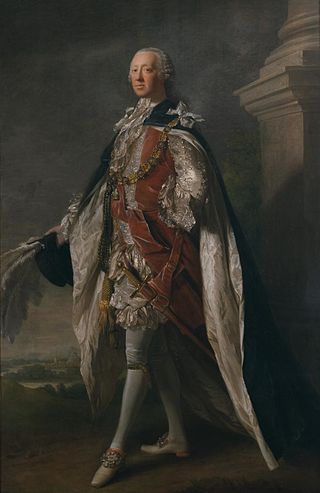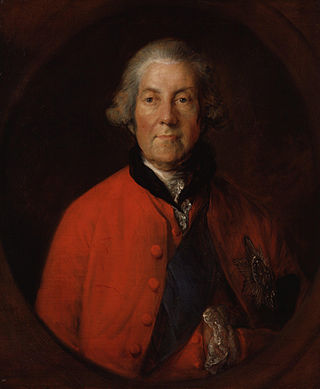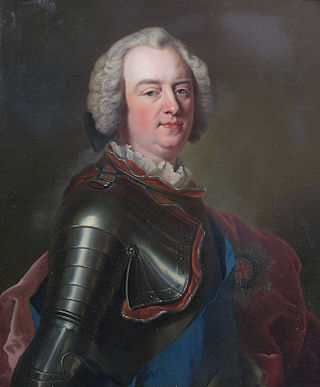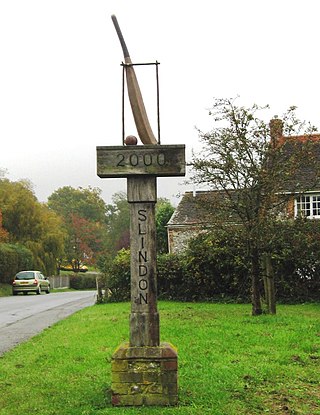Related Research Articles

John Montagu, 4th Earl of Sandwich, PC, FRS was a British statesman who succeeded his grandfather Edward Montagu, 3rd Earl of Sandwich as the Earl of Sandwich in 1729, at the age of ten. He held various military and political offices, including Postmaster General, First Lord of the Admiralty, and Secretary of State for the Northern Department. He is also known for the claim that he was the inventor of the sandwich.

Richard Grenville-Temple, 2nd Earl Temple,, was a British politician. He is best known for his association with his brother-in-law William Pitt with whom he served in government during Britain's participation in the Seven Years War between 1756 and 1761. He resigned, along with Pitt, in protest at the cabinet's failure to declare war on Spain.

John Russell, 4th Duke of Bedford, was a British Whig statesman and peer who served as the Lord Lieutenant of Ireland from 1757 to 1761. A leading member of the Whig party during the Seven Years' War, he negotiated the 1763 Treaty of Paris which ended the conflict. Bedford was also an early promoter of cricket and a patron of the arts who commissioned numerous works from prominent artists, most notably Canaletto.

George Montagu-Dunk, 2nd Earl of Halifax, was a British statesman of the Georgian era. Due to his success in extending commerce in the Americas, he became known as the "father of the colonies". President of the Board of Trade from 1748 to 1761, he aided the foundation of Nova Scotia, 1749, the capital Halifax being named after him. When Canada was ceded to the King of Great Britain by the King of France, following the Treaty of Paris of 1763, he restricted its boundaries and renamed it "Province of Quebec".

Northamptonshire County Cricket Club is one of eighteen first-class county clubs within the domestic cricket structure of England and Wales. It represents the historic county of Northamptonshire. Its limited overs team is called the Northants Steelbacks – a reference to the Northamptonshire Regiment which was formed in 1881. The name was supposedly a tribute to the soldiers' apparent indifference to the harsh discipline imposed by their officers. Founded in 1878, Northamptonshire (Northants) held minor status at first but was a prominent member of the early Minor Counties Championship during the 1890s. In 1905, the club joined the County Championship and was elevated to first-class status, since when the team have played in every top-level domestic cricket competition in England.

Charles Lennox, 2nd Duke of Richmond, 2nd Duke of Lennox, 2nd Duke of Aubigny, of Goodwood House near Chichester in Sussex, was a British nobleman and politician. He was the son of Charles Lennox, 1st Duke of Richmond, 1st Duke of Lennox, the youngest of the seven illegitimate sons of King Charles II. He was the most important of the early patrons of the game of cricket and did much to help its evolution from village cricket to first-class cricket.
In the years from 1726 to 1750, cricket became an established sport in London and the south-eastern counties of England. In 1726, it was already a thriving sport in the south east and, though limited by the constraints of travel at the time, it was slowly gaining adherents in other parts of England, its growth accelerating with references being found in many counties. Having been essentially a rural pastime for well over a century, cricket became a focus for wealthy patrons and gamblers whose interests funded its growth throughout the 18th century.

The 1744 cricket season in England is remembered for the earliest known codification of the Laws of Cricket. This was drafted by members of several cricket clubs, though the code was not published until 1755. Much of its terminology such as no ball, over, toss, umpire and wicket remain in current use. The season is also notable for the two earliest known surviving match scorecards. The second of those matches, played on Monday, 18 June, was a celebrated event in which a Kent county team challenged an England team at the Artillery Ground, Kent winning by one wicket.

Richard Newland was an English cricketer of the mid-Georgian period who played for Slindon and Sussex under the patronage of Charles Lennox, 2nd Duke of Richmond. He also represented various England teams and, in some matches, led his own select team. The eldest of three cricketing brothers, he is generally recognised as one of cricket's greatest early players and has been called a pioneer of the sport.

Bedfordshire County Cricket Club is one of 20 Minor County clubs within the domestic cricket structure of England and Wales. It represents the historic county of Bedfordshire.
Sussex county cricket teams have been traced back to the early 18th century but the county's involvement in cricket dates from much earlier times as it is widely believed, jointly with Kent and Surrey, to be the sport's birthplace. The most widely accepted theory about the origin of cricket is that it first developed in early medieval times, as a children's game, in the geographical areas of the North Downs, the South Downs and the Weald.
The 1743 English cricket season was the 47th cricket season since the earliest recorded eleven-a-side match was played. Details have survived of 18 eleven-a-side and three single wicket matches.
The 1746 English cricket season was the third season following the earliest known codification of the Laws of Cricket.

Edward Aburrow Sr., also known as Cuddy, was an English cricketer of the mid-Georgian period who played for Slindon and Sussex under the patronage of Charles Lennox, 2nd Duke of Richmond. He also represented various England teams. A resident of Slindon, Sussex, he was a contemporary of the three Newland brothers – Richard, John and Adam – who were his colleagues in the Slindon team. Outside of cricket, Aburrow Sr was a tailor in Slindon but he became involved in smuggling. He was jailed in 1745, though he turned King's evidence to gain parole. He relocated to Hambledon, Hampshire and his son Edward Aburrow Jr, also known as "Curry", became a regular Hambledon player.

Huntingdonshire County Cricket Club is one of the county clubs which make up the minor counties in the English domestic cricket structure, representing the historic county of Huntingdonshire. The club does not currently compete in either the Minor Counties Championship or MCCA Knockout Trophy, but does play informal matches, typically against armed forces teams and county academies.

Richmond Green cricket ground, on The Green at Richmond, London, has been a venue for cricket matches since the 17th century. The earliest reference dates from May 1666 and some top-class matches were played there in the first half of the 18th century. A match in 1731, which culminated in a riot, is the earliest in cricket history of which team scores are known. The result of a match in July 1741 is the sport's earliest known tie.
Cow Meadow, renamed Becket's Park in 1935, was an 18th-century county cricket venue situated alongside the River Nene near the centre of Northampton. It is known to have been used for two matches in August 1741. On Saturday, 15 August, a combined Northamptonshire & Huntingdonshire team played Bedfordshire and won. The second match on Tuesday, 18 August, was between Northamptonshire and Buckinghamshire and played for 20 guineas per side.
References
- ↑ ACS, p.21.
- 1 2 3 Other matches in England 1741, CricketArchive. Retrieved 13 January 2019.
- 1 2 3 4 Waghorn, 1899, p.26.
- ↑ Maun, p.104.
- 1 2 3 McCann, p.18.
- ↑ Maun, p.105.
- 1 2 3 Waghorn 1906, p.12.
- 1 2 3 4 5 Waghorn 1899, p.27.
- ↑ McCann, pp.20–21.
- 1 2 3 Maun, p.108.
- 1 2 3 4 Maun, pp.106–107.
- 1 2 Man, p.106.
- ↑ McCann.
- ↑ Marshall.
- ↑ McCann, p.20.
- ↑ Buckley, p.16.
- ↑ Main, p.99.